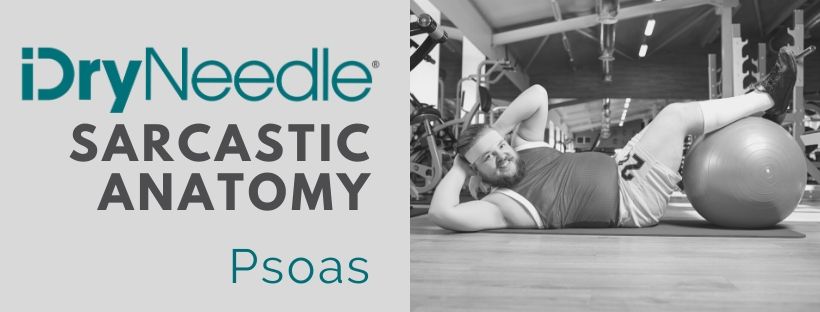


Frustrating 6th grade spelling bee participants for decades, the psassy little psoas doesn’t like to pronounce his P’s. Pso dumb.
Editor’s note: I seriously considered writing this entire blog with a silent ‘P’ in front of every word starting with an ‘S’, but that one sentence up top already annoyed me. You’re welcome for that.

Where to start…?
First, the psoas literally connects your upstairs to your downstairs, from the lumbar spine to your femur - but clearly wants nothing to do with the pelvis. Passing directly through the bowl of the inner pelvis between the anterior-inferior iliac spine (AIIS) and pubic symphisis, deep to the inguinal ligament without even as much as a “hey neighbor” as it traverses past the innominate. Kinda like when your sibling keeps saying “I’m not touching you. I’m not touching you!” as they stand ½ an inch from your face and mirror your every move. Saliva from each “ch” sound misting your cornea. As a middle child, I can attest there is no legal way to mitigate this passive-aggressive instigation… aside from a body check or slap in the face. Which lands YOU in timeout. Maybe psoas acts this way because phonetically the pelvis uses it’s P’s appropriately?! One can only speculate.

Or maybe “the sibling” in this anatomical context is iliacus who certainly does originate on in the inner iliac fossa and conjoins distally to form the iliopsoas attachment at the lesser trochanter of the femur.

Otherwise, for how much recognition psoas gets as a hip flexor, when you look at the morphology of this fusiform muscle – methinks it may be misunderstood. One look at the cross-sectional area (CSA) anywhere in the lumbar spine and you’ll clearly see psoas contributes significant mass with its anterior attachments to L1 through L5. That’s not a fat joke, although I would certainly advise caution when using terms like “significant mass” in any other context with friends and family. But here this structural mass suggests strength and stability! Yes, we need synergistic and cylindrical contributions to our “core” from the abdominals, paraspinals, pelvic floor and even the diaphragm; but psoas has to be considered in the context of co-contractive stability of the lumbar spine.

The intrinsic properties of psoas reveal a real Jekyl and Hyde, comprised of both fast- and slow-twitch fibers. Essentially, fast to anger and will hold a grudge fooooreeeeever.
That explains why it’s given credit for both postural maintenance of the spine and phasic flexion of the hip. And also likely explains why psoas is often the clinical anti-hero of proper lumbar mechanics and pelvic posture in general. If you’ve ever been told you have an “anterior pelvic tilt” or “excessive lordosis” of the lumbar spine…you were also likely told it was psoas’ fault.
Beyond that, this diagnosis of psoas-related dysfunction typically precedes some of the most uncomfortable and emotionally-distressing treatment strategies of your life. First comes education on one of the more acrobatic and physically-compromising stretches created - which may or may not include a wall, a stretching-strap, various aerial yoga apparatus, twisting/reaching motions, and physical over-pressure which has ripped many-a-skinny-jean.


Or maybe your rehab approach included deep soft tissue techniques. Recently banned by NATO as cruel and inhumane, a “psoas release” involves manual- or blunt object-pressure into the abdomen with the goal of direct myofascial impact. To be sure, this isn’t a massage and there is a reason your therapist won’t ask where you are on the 0-10 pain scale during this maneuver. Also, NEVER schedule a session involving this tactic after a Chipotle lunch. Just don’t.
All jokes aside (for a second), static stretching and soft tissue techniques have their place if psoas is contributing to pain or movement dysfunction. And the stretching motion can be rather simple in a half-kneel position with the correct cues. No strap, wall, or skinny jeans needed. But in terms of psoas-tightness (especially from prolonged sitting), I think it may be more appropriate to consider this muscle as short-and-weak. Which adds an aspect to rehab that is very often overlooked… STRENGTHENING. Not necessarily straight-up hip flexion strength, but psoas as it contributes to “core strength”.
“But Paul, I’ve already got rock-hard abs. How do I add psoas to my current program?”
Glad you asked. Because again, I don’t think we need more open-chain hip flexor strength or even necessarily strengthening psoas in a hip flexed position. We also don’t need to re-invent core stability training now that we appreciate psoas is involved. So I think the solution is having a psoas- or pelvic position-emphasis with some of the ol’ faithfuls of core training.
Here are 2 examples –
1) Planks.
Nope, not that kind.
This kind. One of the most pure and naturally-comprehensive core exercises there is. Add some psoas-love by rolling your pelvis posteriorly (tuck you tailbone) or even give a nice hard glute squeeze. The glute clench brings in an element of reciprocal inhibition, which means if your booty is on, the flexors are off momentarily. Otherwise if you want to keep it simple, just don’t let your low back dip or arch into lordosis – that’s a good indicator psoas is saying “F it, I’m out” and allowing the spine to rely on ligamentous support and all the other core players. The other major benefit to planking is that it is the anti-sit with hip/trunk in neutral.
2) The hollow hold or hollow rock.
This exercise has gained popularity of late and again if done properly will reflexively recruit all anterior core muscles. Although we are migrating into some degree of hip flexion, don’t let that be the primary motion/position – this should be an obvious ab-burner vs hip-fatiguer. It may be a little advanced for beginners so don’t consider this core 101, but it is an excellent final progression for the core-deficient.
Lastly, since I am who I am and almost always look at anatomy and rehab in the context of dry needling application... Psoas is a muscle that is rarely targeted directly with DN. It’s an advanced technique and hope it’s obvious to say we would never approach it anteriorly through the abdomen. Right? Can we all agree on that? There are techniques which approach it posteriorly or at the lateral pillar of the spine, but you’re tip-toeing past some delicate structures.
Here are likely some more common ways dry needling may be included in your rehab if psoas has been identified as contributing to dysfunction...
1) Target the distal attachment in the anterior hip, possibly including rectus femoris – the focus here would be to improve hip extension mobility
2) Treating lumbar paraspinals - this has both a stability-component and agonist-antagonist impact on psoas
3) DN to the glutes – if psoas is short-and-weak from prolonged sitting, it’s possible the glutes are long-and-weak? Or just flat. Asleep. Amnesiac.
Anyways, I hope something in here was helpful in some way. If you are experiencing hip pain or low back pain - first try standing and walking more often. Or dust off that core program from years ago. If that doesn’t help, it may be worth having a PT or rehab professional take a look. Just remember what I said about skinny jeans, and Chipotle.
But as I sit and gaze out of my window on a gloomy, overcast PNW afternoon environs, and raindrops lazily drip from the dogwood branches outside my office as if to say, “I forgive you for not trimming me 2 weeks ago on that one sunny Saturday that you knew was going to be the last”…the wise words of a poet from the late 90s appear in my mind as the only appropriate conclusion to our scholarly endeavors heretofore.
If you take nothing from this discourse on the sassy psoas, remember this...
“The hips don’t lie”
~Shakira Shakira
Thanks for reading!





















